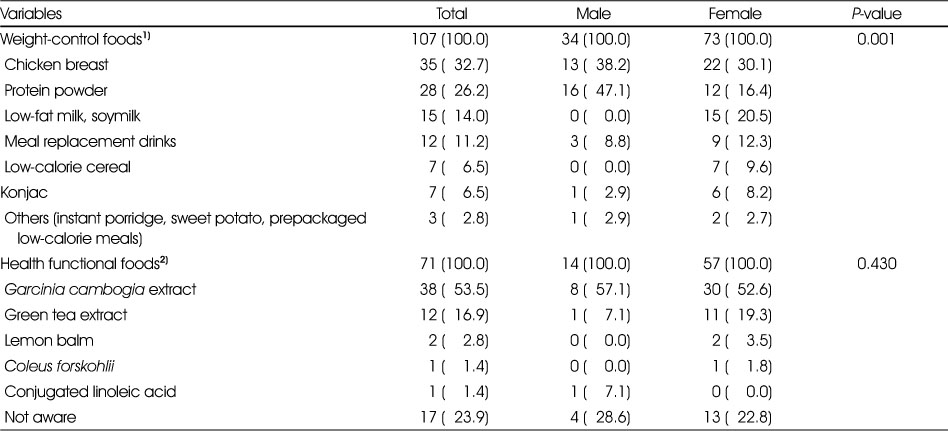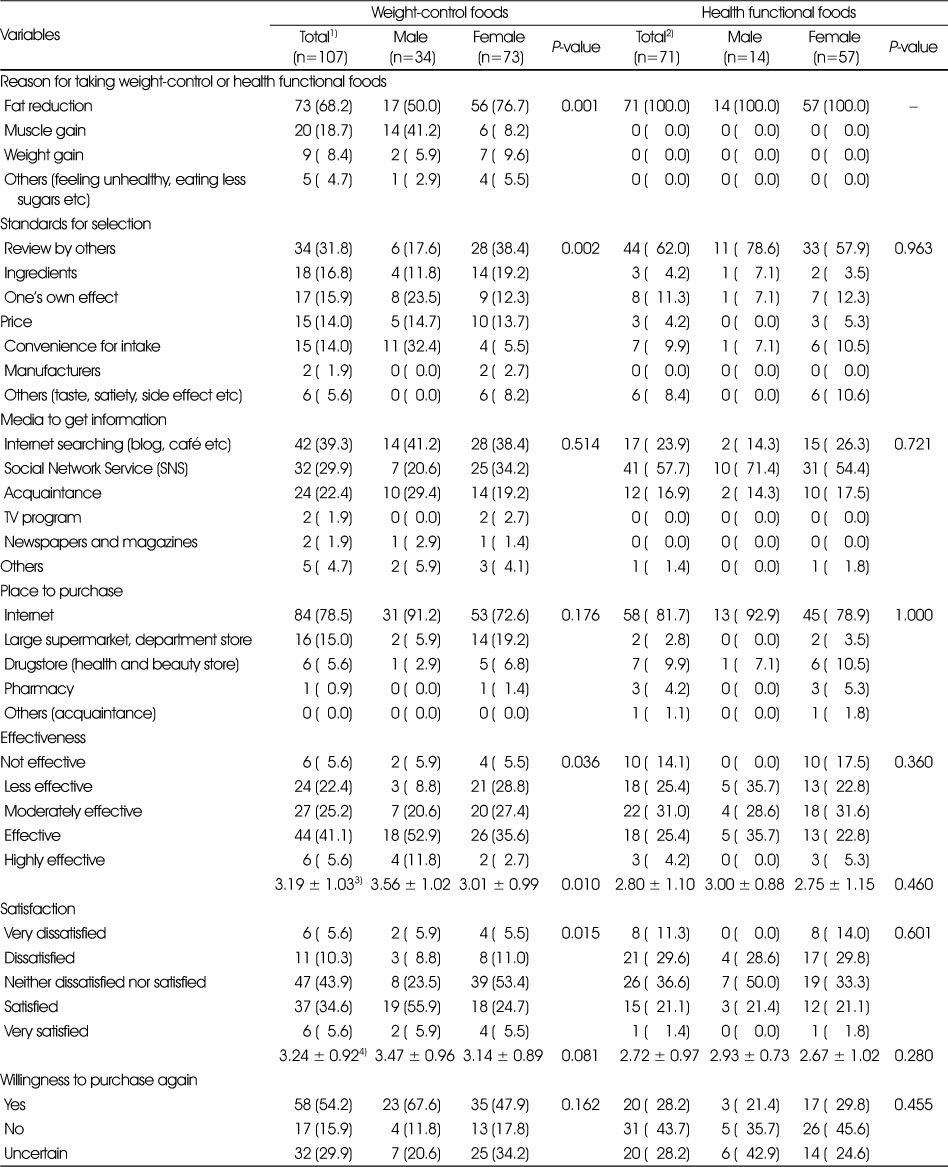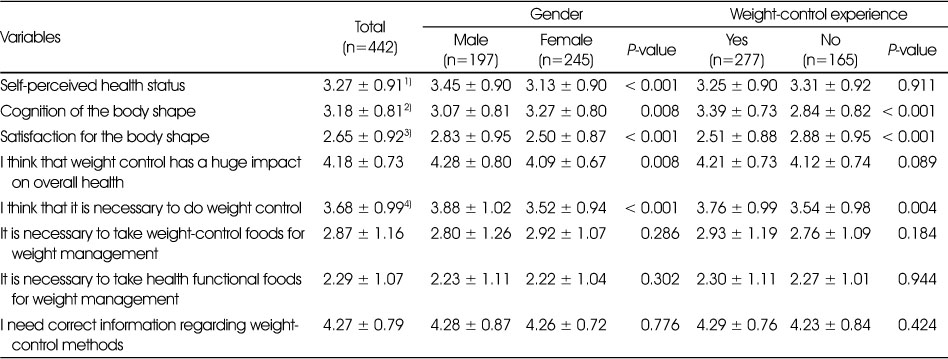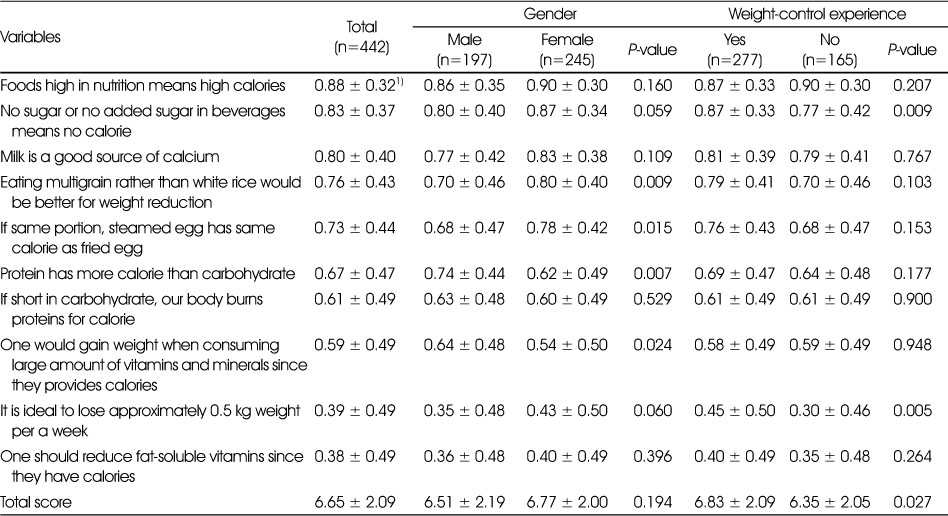Articles
- Page Path
- HOME > Korean J Community Nutr > Volume 26(1); 2021 > Article
- Research Article
- Use of Weight-control or Health Functional Foods, Associated Weight-control Behavior and Perception among University Students in Cheongju
- Gayong Kim, Munkyong Pae
-
Korean Journal of Community Nutrition 2021;26(1):23-36.
DOI: https://doi.org/10.5720/kjcn.2021.26.1.23
Published online: February 28, 2021

2Professor, Department of Food and Nutrition, Chungbuk National University, Cheongju, Korea

-
Corresponding author:
Munkyong Pae, Tel: +82-43-261-2745, Fax: +82-43-267-2742,
Email: mpae@chungbuk.ac.kr
- 1,269 Views
- 14 Download
- 14 Crossref
- 0 Scopus
Abstract
Objectives
This study sought to assess the prevalence and duration of weight-control or health functional food use, associated weight-control behavior, perception, and knowledge among university students.
Methods: The subjects were 442 university students in Cheonju, Korea, and data was collected by a self-administered questionnaire. Both X2 and t-tests were conducted for categorical and mean comparisons.
Results: An estimated 62.7% (female 69.0%, male 54.8%) had ever attempted weightcontrol. Among these, an estimated 59.2% of females and 38.9% of males had used weight-control or health functional foods with significant gender difference. The weightcontrol foods commonly used included chicken breast, protein powder, low-fat milk and soymilk, and meal replacement drinks, while garcinia cambogia extract and green tea extract were frequently used as health functional foods. One of 10 (10.3%) consumers of weight-control foods reported ≥ 7 months use, with less frequent long-term consumption of health functional foods (4.2%). The average degree of satisfaction was 3.24 ± 0.92 for weight-control foods and 2.72 ± 0.97 for health functional foods on a 5-point scale, meaning ‘slightly satisfied’ and ‘slightly dissatisfied’, respectively. Females or students with an experience of weight-control reported poorer perceptions of their health and body image as well as a higher need for weight control. Besides, both male and female subjects felt a high need for correct information regarding weight-control methods.
Conclusions: Our results provide a better understanding of the characteristics associated with the use of weight-control or health functional foods among university students and will be useful in developing a nutrition education program by incorporating correct body image, knowledge, and practical yet desirable practices for weight control.
Published online Feb 28, 2021.
https://doi.org/10.5720/kjcn.2021.26.1.23
Use of Weight-control or Health Functional Foods, Associated Weight-control Behavior and Perception among University Students in Cheongju
Abstract
Objectives
This study sought to assess the prevalence and duration of weight-control or health functional food use, associated weight-control behavior, perception, and knowledge among university students.
Methods
The subjects were 442 university students in Cheonju, Korea, and data was collected by a self-administered questionnaire. Both χ2 and t-tests were conducted for categorical and mean comparisons.
Results
An estimated 62.7% (female 69.0%, male 54.8%) had ever attempted weight-control. Among these, an estimated 59.2% of females and 38.9% of males had used weight-control or health functional foods with significant gender difference. The weight-control foods commonly used included chicken breast, protein powder, low-fat milk and soymilk, and meal replacement drinks, while garcinia cambogia extract and green tea extract were frequently used as health functional foods. One of 10 (10.3%) consumers of weight-control foods reported ≥ 7 months use, with less frequent long-term consumption of health functional foods (4.2%). The average degree of satisfaction was 3.24 ± 0.92 for weight-control foods and 2.72 ± 0.97 for health functional foods on a 5-point scale, meaning ‘slightly satisfied’ and ‘slightly dissatisfied’, respectively. Females or students with an experience of weight-control reported poorer perceptions of their health and body image as well as a higher need for weight control. Besides, both male and female subjects felt a high need for correct information regarding weight-control methods.
Conclusions
Our results provide a better understanding of the characteristics associated with the use of weight-control or health functional foods among university students and will be useful in developing a nutrition education program by incorporating correct body image, knowledge, and practical yet desirable practices for weight control.
Table 1
General characteristics of subjects
Table 2
Use of weight-control or health functional foods
Table 3
Kinds for weight-control or health functional foods used by the subjects
Table 4
Consumption patterns of weight-control or health functional foods
Table 5
Attitude toward weight-control or health functional foods
Table 6
Perception of the subjects regarding body shape and weight-control
Table 7
Weight-related nutrition knowledge of the subjects
References
-
Ministry of Health and Welfare, Korea Disease Control and Prevention Agency. Korea National Health and Nutrition Examination Survey (KNHANES VII-3). Korea Disease Control and Prevention Agency; 2019 Dec.Report No. 117002.
-
-
Chin JH, Chang KJ. College students' attitude toward body weight control, health-related lifestyle and dietary behavior by self-perception on body image and obesity index. J Korean Soc Food Sci Nutr 2005;34(10):1559–1565.
-
-
Kim MR, Kim HC. A study on diet behaviors and related factors in dieting college students. J East Asian Soc Dietary Life 2008;18(1):135–148.
-
-
Kim MH, Kim YJ, Chung JS, Yeon JY. Fad diet status of male and female collegians. Korean J Food Nutr 2015;28(2):258–268.
-
-
Ministry of Food and Drug Safety. Analysis on domestic market of health functional foods in 2014 [internet]. 2015 [cited 2020 Dec 21].Available from: https://www.mfds.go.kr/brd/m_
374/view.do?seq=30197.
-
-
Ministry of Food and Drug Safety. The production output of food and food additives in 2019 [internet]. 2020 [cited 2020 Dec 21].Available from: https://www.mfds.go.kr/brd/m_
374/view.do?seq=30200.
-
-
Lee JY, Jeong YJ, Kim CY. Obesity and dietary supplements for weight loss. Food Ind Nutr 2019;24(2):30–40.
-
-
Park MH, Choi YS. A survey on weight control diets practiced by college women in Taegu and Kyung Buk. J Korean Diet Assoc 1998;4(2):200–211.
-
-
Hong MS, Pak HO, Sohn CY. A study on food behaviors and nutrient intakes according to body mass index and body image recognition in female university students from Incheon. Korean J Food Nutr 2011;24(3):386–395.
-
-
Lee HJ. Influence on in-dorm university students' body-shape perception, obesity, and weight control toward obesity stress. J Digit Policy Manag 2013;11(11):573–583.
-
-
Lee JH, Hu W. Body image perception, weight control and dietary behavior of university students in Daejeon. Korean J Human Ecol 2017;26(4):353–367.
-
-
Lee JH. A study on BMI, diet perception and dietary behavior of female university students. J Korean Appl Sci Technol 2020;37(3):436–472.
-
-
Kim MH, Yeon JY. Fad dieting status and need for nutrition education on healthy dieting of the university students according to the desired loss weight. Korean J Food Nutr 2017;30(3):473–481.
-
-
Seol YH. In: Consumer perception toward antiobesity functional foods by women employees in their thirties and forties residing in capital region of Korea [master's thesis]. Chung Ang University; 2011.
-
-
Park MY, Kong KH, Lee MS. Consumer perception survey on the health functional foods for weight control. J East Asian Soc Diet Life 2019;29(2):148–158.
-
-
Lee HJ, Won HS, Kwak JS, Kim MK, Kwon OR. Perceptions of body shape and weight control in individuals consuming weight-control or health functional foods. Korean J Nutr 2011;44(3):243–254.
-
-
Won HS, Lee HJ, Kwak JS, Kim JH, Kim MK, Kwon OR. Study on purchase and intake patterns of individuals consuming dietary formula for weight control or health/functional foods. Korean J Nutr 2012;45(6):541–551.
-
-
Han CJ. Study on perception of weight control and patterns of diet/low-calorie food consumption according to weight status in adult women. J East Asian Soc Diet Life 2017;27(2):104–113.
-
-
Lee SL, Lee SH. Survey on health-related factors, nutrition knowledge and food habits of college students in Wonju area. Korean J Community Nutr 2015;20(2):96–108.
-
-
Jo YR. In: The study on nutrition intake under eating behavior and diet habits of women students in universities in Seoul [master's thesis]. Konkuk University; 2010.
-
-
Korean Society for the Study of Obesity. Guideline for treatment of obesity. . Seoul: Korean Society for the Study of Obesity; 2012. pp. 17-21.
-
-
Park MS, Kim HJ, Im EJ. Effect of appearance concern on the acceptance of men's make-up behavior among college students. J Invest Cosmetol 2020;16(1):89–99.
-
-
You JH, Won SH, Lee OH. Diet, are you healthy? recognition and diet methods in students of natural science college. Yong In Univ Stud Life Res 2009;16:101–114.
-
-
Ko SJ, Song JH, Lee JH, Lee HE, Hwang HJ. Factors influencing intake of weight loss products of female college students. J Korea Acad Ind Coop Soc 2018;19(3):456–467.
-
-
Jeong SM. In: The effect of the attitude and subjective norms on purchase intention of diet food [master's thesis]. Keimyung University; 2018.
-
-
MPhil AM, Bessell E, Lauche R, Adams J, Sainsbury A, Fuller NR. Effectiveness of herbal medicines for weight loss: a systematic review and meta-analysis of randomized controlled trials. Diabetes Obes Metab 2020;22(6):891–903.
-
-
Kang NE, Kim JH, Yoon HR. Study on differences in perception of weight management, balanced food intake, knowledge of obesity, and nutrition knowledge in male and female university students. Korean J Food Cult 2012;27(6):756–768.
-
-
Doo MA, Kim YH. Recognition of body weight loss according to age and gender. Korean Nutr Soc 2007;40(7):658–666.
-
-
Kim HK, Kim JH, Jung HK. A comparison of health related habits, nutrition knowledge, dietary habits, and blood composition according to gender and weight status of college students in Ulsan. Korean J Nutr 2012;45(4):336–346.
-
-
Lee KS, Kim KN. Effects of nutrition education on nutrition knowledge, dietary attitudes, and food behavior of college students. Korean J Community Nutr 1997;2(1):86–93.
-

 KSCN
KSCN








 Cite
Cite


